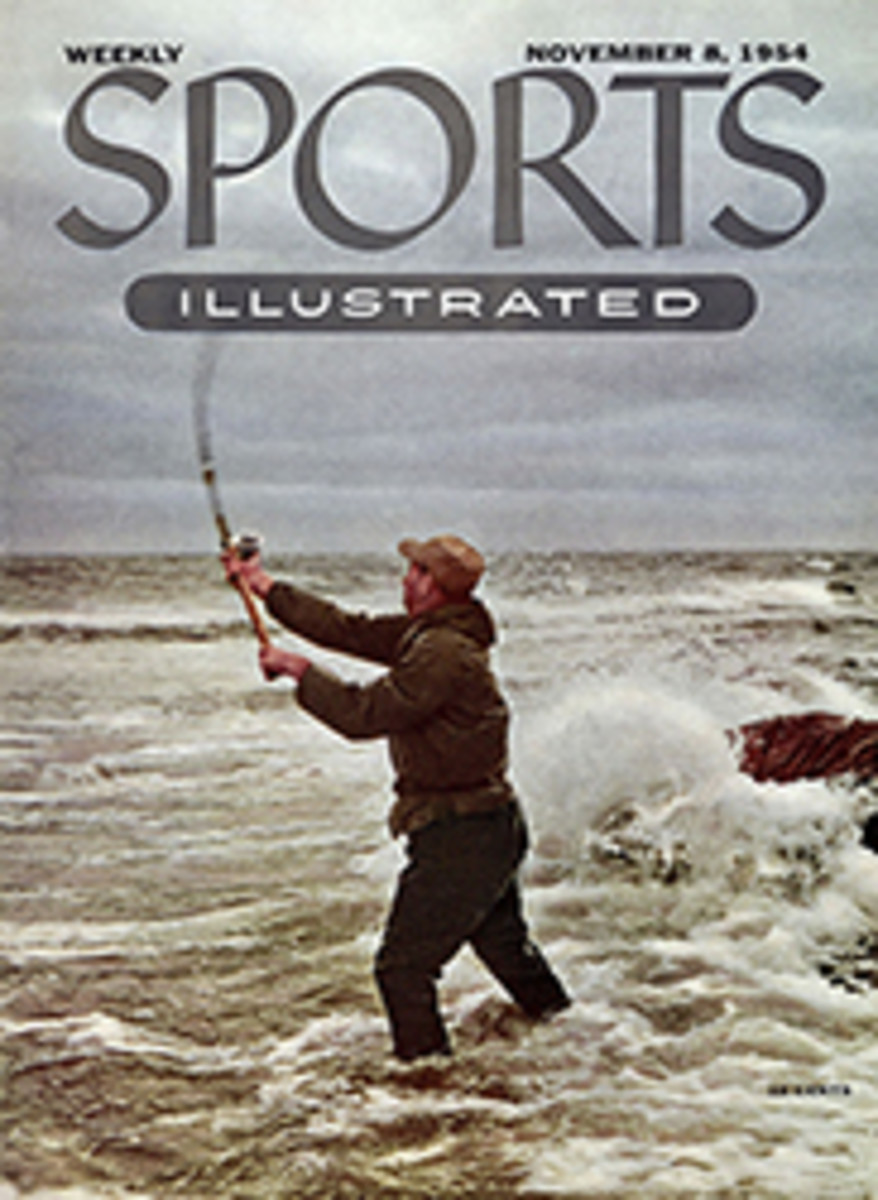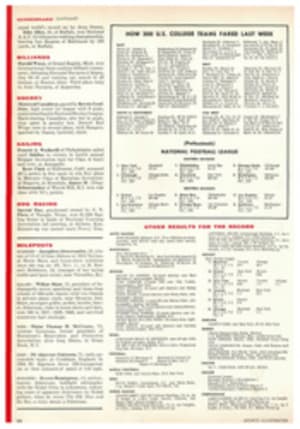
THE WONDERFUL WORLD OF SPORT
UP IN THE HANDS OF THE LORD
The free balloon hasn't changed much since the world's first aeronaut, Pil√¢tre de Rozier, ascended over Paris in 1783. Yet even in this day of greater aerial wonders there is some old magic in a balloon that draws people to it—perhaps because each ascent captures a little of de Rozier's first adventure. This is a word and picture report by an SI staff writer who lived through a balloon adventure last week.
In the pre-dawn of Sunday, Oct. 24, in Valley Forge, Pa., crewmen of the Balloon Club of America started gas flowing into the vast, lifeless fabric of experimental balloon N9073H. For four hours they moved around it, setting sandbags against its rising strength, until at 9:40 a.m. it stood over them, tugging in the wind, seemingly impatient to be away. The ground crew cast it free and suddenly its impatience was gone. It slowly lifted its crew away from the land, floating with the wind.
The pilot of this flight was the ex-Navy balloonist Don Piccard, son of the stratosphere explorers, Jean and Jeannette Piccard. With him was a crew of four: his wife, Joan, a veteran aviatrix, Connie Wolf, and two new crewmen, Tony Bryan and I, both making our first ascent.
As balloonists keep saying, there is nothing else like it. Our balloon drifted through absolute stillness, hanging in the sky on a simple law of physics. Traveling at the exact speed of the wind, we felt no wind.
To photograph the others, I rode four feet above them, crouching, quite frankly, like an apprehensive gibbon on the wooden load ring from which the basket hangs. Hooked on a net line, actually I was safe enough so long as I watched my hands. A half foot in front of me were the control lines: one cord to hold the "appendix"—the balloon's safety vent—another to operate the gas valve in descent and, third, the rip panel line, a bright red tape purposely different in color and feel so no one would mistakenly pull it in mid-air. Pulling it opened a 20-foot gash, suddenly releasing all the gas—a device used only on the ground to prevent dangerous dragging.
The voices of the four in the basket below me broke cleanly and sharply as sounds do high on a mountain. When no one spoke, our senses stretched out, and we could hear the small, particular noises of a toy world below—the shuffling of traffic and trains, barnyard chattering, gunshots, a dog barking. "You think of all the houses and people," said Piccard, "but then think of all the stumps in the woods and all the ants in each stump." His wife Joan spotted a new housing development where the builders had left trees, real trees, standing.
We could not feel it, but from the map and our racing shadow we knew we were riding a 30-mile wind across Philadelphia suburbs, then across the Delaware River. At 10:25 we were 4,000 feet over New Jersey. "Artists' paints on a palette," mused Joan Piccard, looking down at refinery tanks by the river. We said little for the next 10 minutes, until Joan had a more prosaic, wifely thought. "Don, I think the orange cat is locked in our utility room."
It was 10:38 by my watch—not yet an hour. Ahead there was a glint of water. At 10:40 exact I would ask Piccard our location and altitude and enter it in the log.
A whoof-whoof sound came from above us. I looked down at Piccard. He looked at me. "I didn't touch anything," I said. We all looked up.
With a terrifying suddenness the whole bottom of the balloon swirled inward.
4,200 FEET UP: "WE'VE HAD IT"
Piccard gave a cry. "We've had it. The rip panel's gone." In the first shocking moment of fear I did nothing but stare at Piccard cutting the appendix cord with a knife, then at the ground, then at the twisting, shrinking fabric above. "It's sticking on the valve line," Piccard again cried, slashing with his knife. "We've got to parachute it."
The rest of his words dissolved into jabber. Dumbly, all thumbs, I worked to unbuckle myself from the net, my mind clutching for some hope and finding little. Somebody 100 years ago had parachuted in a burst fabric. Had there been others like us, with no special parachute rig? With no valve line to guide the collapsing fabric?
Then as I crawled and slid down through the hoop to the basket, I could see the faces of the other four, but I could not tell if they were afraid. "Throw the ballast," Connie Wolf said.
"The sand first," Piccard ordered, "then bags, and we won't hurt anyone below. There's no gas left. We're on complete parachute." The sand fell behind us in an arc. The bags hung even with us for a moment, then fell away. Air was siffling up, rustling papers in the bottom of the basket. "Our rate is 2,000 a minute," Piccard said. "Maybe more. The needle only goes to 2,000." This must be fast. I thought—that heavy fabric, the basket, and five people totaling one ton, and the fabric still curling in. As our parachute got smaller, we would go faster.
"I knew, I told you...and I don't even get to be a widow," whimpered Joan Piccard.
"We'll make a parachute landing. Don knows what he is doing," said Tony Bryan.
1,000 FEET TO GO
"We're in the hands of the Lord," said Piccard.
A thousand feet more, I thought.
"When we hit, brace with your hands on the basket," Piccard said. "Practice once now so we give each other room." We squatted, tight against each other in the four-by-five basket. The land was tilting away now. Oscillation, I thought. That's not good. A woods was now below, then a field of winter cover, and a barn growing large on my right. It would be hell to hit a barn.
"I'm throwing the heavy stuff," I shouted.
"Yes, everything. The seats."
Five hundred feet now. I had never seen it come up so fast in a plane. "We're going to clear the high tension wires," someone said. I saw wires. A road. I thought of my wife. I tried to recall past experiences that might serve me now, but only the words of Chris Kogel, an old gymnast, seemed to apply: "Break the fall with your arms. Then tuck. Tuck and roll."
"Watch the load ring," said Bryan. "It will come down on us when we hit."
"We're going into the man's peach trees," said Joan. Lines of green swept up. I never felt the impact. Suddenly we were back in the air, then rolling, bounding, body against body in a brown darkness.
I was lying half across Connie Wolf's legs. Joan was somewhere to the right of me moaning. She had broken a leg and foot. Bryan and I had broken toes. None of us knew how we had come out of it so lightly, or cared to think how much worse it might have been. We had come down 2,000 feet a minute, impacting with three times the force of a standard parachute fall.
"YOU WERE LUCKY"
I stood by the battered equipment, while the others took Joan to a hospital. A Mr. Blaine Heritage, who had been walking his dog as we flashed over at 100 feet told me, "You were lucky. Missed the wires, hit in the asparagus field, bounced four feet up again and landed in the barley."
State Trooper Parvin Stryker came through the gathering crowd, puzzling over a pink accident form. "Make or model?" he asked.
"It was a free balloon when we left Valley Forge," I said.
"It's a convertible," someone suggested.
While I waited for the others to return, a Mr. William Hazleton asked me if I would like to have my picture taken. In another hour the crowd dispersed and cars no longer stopped to ask if a balloon had fallen. By one o'clock there were only Mr. Hazleton and I sitting by the road swapping stories on a slow Sunday afternoon.
DOWN IN THE DUST OF JAMAICA
Coming around the last turn in a $3,500 claiming race at Jamaica, John W. Nizlek's Precession was leading by a head. He had won a race only four days earlier. This was his fourth start in 11 days, his 148th in a nine-year career in which he had won $107,710. He had been retired to stud twice; but, said his owner, "He wanted to run."
A hundred feet from home, the 10-year-old stallion—Bobby Stovall up—faded to third. Suddenly, as the excerpts from Jamaica's film patrol (right) show, Precession crashed to the ground, the cannon bone of his right foreleg unaccountably broken.
Stovall plunged on the track and was nearly trampled as New Liberty stumbled over the fallen horse. Luckily he got away with only his wind knocked out. Sidney Cole on New Liberty, who kept his horse up long enough to take third money, walked off. Then the ambulance pulled between Precession and the grandstand. The horse was made to lie down, and the veterinarian shot him through the head.
TWO PHOTOS
FROM BALLOON BASKET JOAN PICCARD LOOKS DOWN ON PENNSYLVANIA FARMLAND. DON PICCARD WAVES TO GROUND CREW
PHOTO
N9073H LEAVES VALLEY FORGE AIRPORT
PHOTO
AFTER CRASH TONY BRYAN COMFORTS INJURED JOAN PICCARD BESIDE BALLOON BASKET
PHOTO
AS A CROWD GATHERS IN THE BARLEY FIELD, PILOT DON PICCARD ROLLS UP THE COLLAPSED BALLOON, REVEALING THE DARK RIP-PANEL SLIP WHICH BURST IN MID-AIR
CHART
FLIGHT AND FALL of the balloon were recorded on the barograph. For an hour (broken into 15-minute intervals by heavy lines on the graph) the balloon climbed gradually until rip panel burst at 4,200 feet, then fell 2,000 feet a minute.
PHOTO
CREW MEMBER PHINIZY EXPLAINS TO OFFICER CLARENCE WINGATE HOW BALLOON FELL
PHOTO
Horse and rider crashed to ground as 10-year-old Precession snapped right foreleg only three strides from finish
PHOTO
Running third, Precession abruptly collapsed, throwing Jockey Stovall to turf as other horses headed for wire
1
PHOTO
[See caption above.]
2
PHOTO
Fourth-running New Liberty tripped, slammed across finish line while Precession struggled up, dragging broken leg
3
PHOTO
[See caption above.]
4
PHOTO
[See caption above.]
5
PHOTO
[See caption above.]
6

